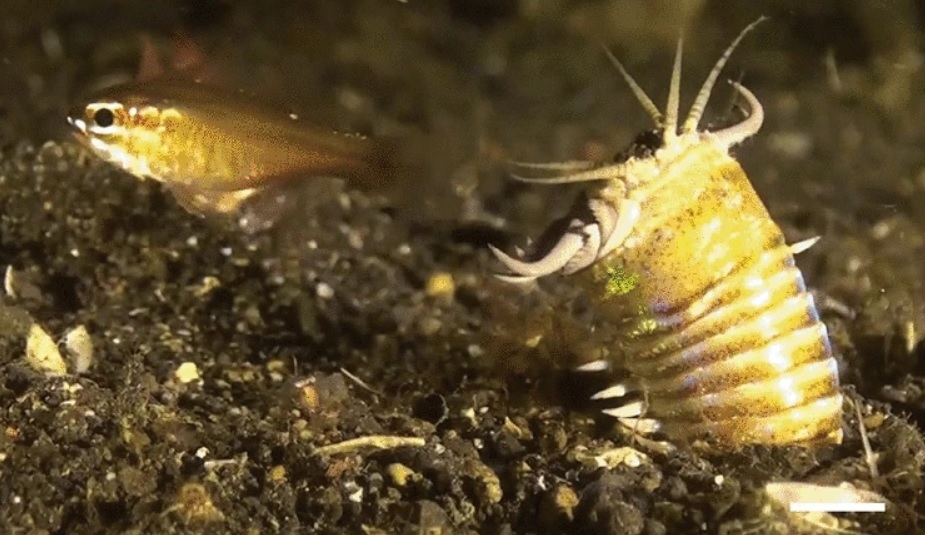(CN) — A large, fossilized marine burrow dating to about 20 million years ago was likely home to giant, ambush-predator worms, according to research published Thursday.
Taiwan’s Yehliu Promontory, a cape extending from Taiwan’s northeastern coast, was entirely underwater 20 million years ago. Thanks to the lowered sea level, humans can now walk and marvel at ancient geological formations where there once was ancient sea floor.
There, in the spring of 2013, geoscientist Ludvig Löwemark of National Taiwan University noticed the trace, fossilized remains of a large marine burrow. He is one of eight authors of Thursday’s findings, which were published in the open access, peer-reviewed journal Scientific Reports.
“I was fascinated by this monster burrow at first glance,” said lead author Yu-yen Pan, a Ph.D. candidate at Simon Fraser University in British Columbia, in a statement. “Compared to other trace fossils which are usually only a few tens of centimetres long, this one was huge; two-meters long and two-to-three centimeters in diameter. The distinctive, feather-like structures around the upper burrow were also unique and no previously studied trace fossil has shown similar features.”
Trace fossils are preserved burrows, footprints or track marks, root cavities and other traces of an animal, rather than fossils of the animal itself. This fossil is an L-shaped burrow whose upper portion is surrounded by wispy, feather-like structures that were revealed by CT scans to resemble a funneling shape.
Without corresponding animal or insect fossils to indicate the burrow’s inhabitants, however, the team had to survey the literature on ancient marine life to find what might have made and lived in the large burrow.
One notable clue was the burrow’s chemical composition. The scientists found that the burrow was lined by iron-rich minerals, suggesting its inhabitant secreted a mucus to stabilize its home. Because the nearby feather-like structures lack this iron, the researchers concluded that the funnels were caused by surrounding sediments’ collapse in reaction to a slender organism’s burrowing behavior.
The most likely candidate? An ancient Bobbit worm, a marine predator that has well earned its nickname, “sand striker.” Bobbit worms rest on the seafloor, hiding in underground burrows where they lie in wait to ambush small fish with their strong jaws.
“To summarize, we hypothesize that about 20 million years ago, at the southeastern border of the Eurasian continent, ancient Bobbit worms colonized the seafloor waiting in ambush for a passing meal,” the authors write in the study. “When prey came close to a worm, it exploded out from its burrow, grabbing and dragging the prey down into the sediment. Beneath the seafloor, the desperate prey floundered to escape, leading to further disturbance of the sediment around the burrow opening.”
Bobbit worms today rebuild their burrows by secreting a mucus and pressing it into the burrow wall, which would account for the fossilized burrow’s chemical composition: bacteria that feed on marine invertebrates’ mucus often foster iron-rich minerals, the scientists note.
The large trace fossil, Pennichnus formosae, is the first trace fossil named in Taiwan. Pennichnus derives from penna, or “feather,” and “ichno,” or “footprint.” Formosa was the Portuguese name for the island of Taiwan, and translates to “beautiful.”
Fossils like these are critical for understanding the lives of ancient animals and insects that were mostly composed of soft tissue, which is rarely well preserved over millennia. This may be the first known trace fossil of a submerged ambush predator.
A Taiwanese YouTube account, Playin’ Stones Studio, released an educational video in tandem with the research’s publication featuring narration by Pan, the study’s lead author.
Subscribe to Closing Arguments
Sign up for new weekly newsletter Closing Arguments to get the latest about ongoing trials, major litigation and hot cases and rulings in courthouses around the U.S. and the world.









